Sustainable Tourism in the Ogasawara Islands: Dolphin Identification Program
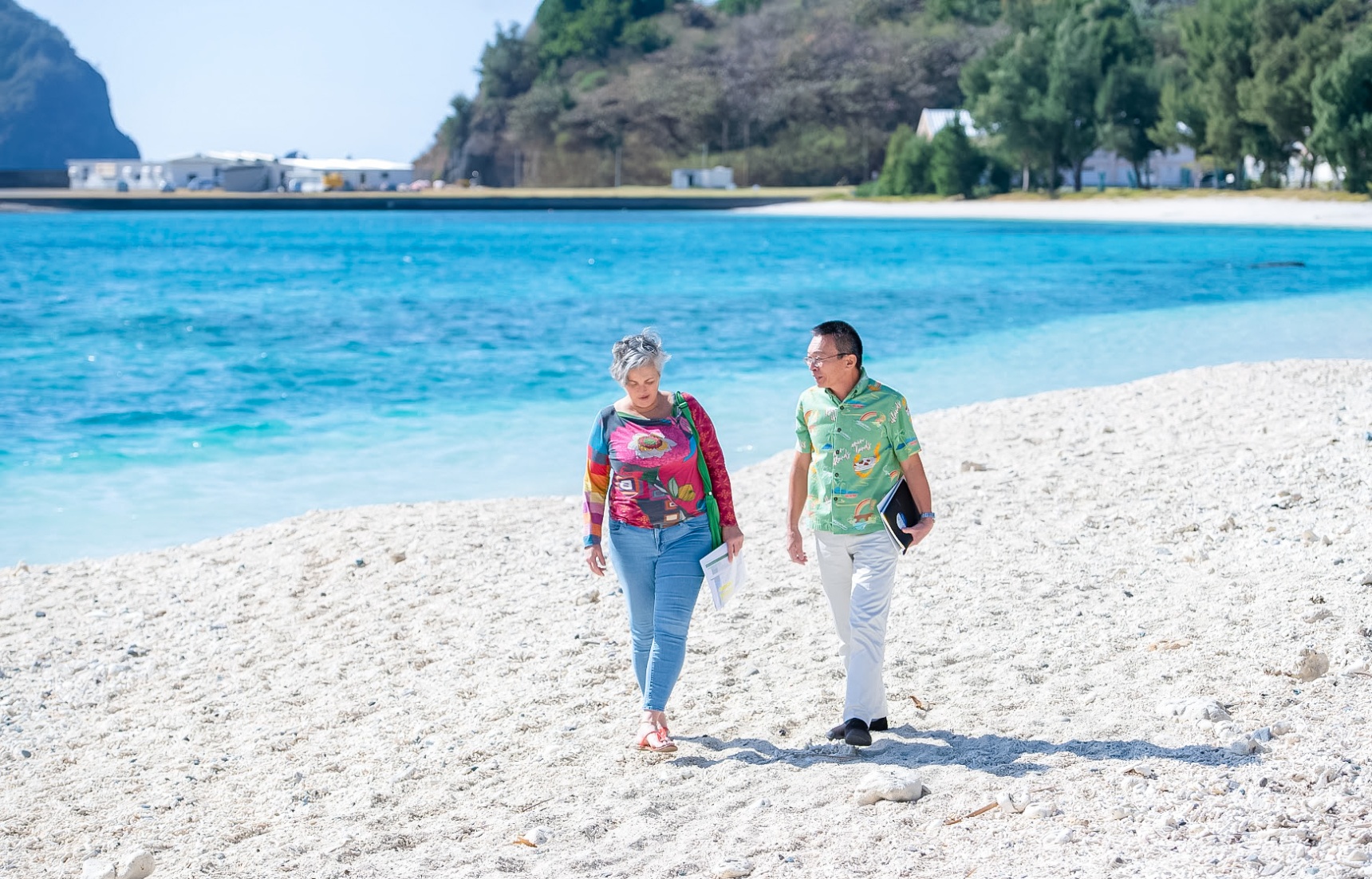
The Ogasawara Islands, 1,000 km south of Tokyo, are only reachable by a 24-hour boat trip. A national park since 1972 and a UNESCO site since 2011, the islands have strict rules for tourists and residents to protect their unique ecosystems.
By AAJ Editorial TeamHere is the digest video of the interview.
Sustainable tourism is promoted, encouraging visitors to enjoy the natural beauty, history, and culture responsibly. Initiatives include using visitor photos and videos to identify dolphins. This series highlights those offering experiences of Ogasawara's nature, history, and culture, while conserving resources and supporting regional development.
【Islander.1】Whale Watching and Dolphin Identification / Koki Tsujii (Senior Researcher at the Ogasawara Whale Watching Association)
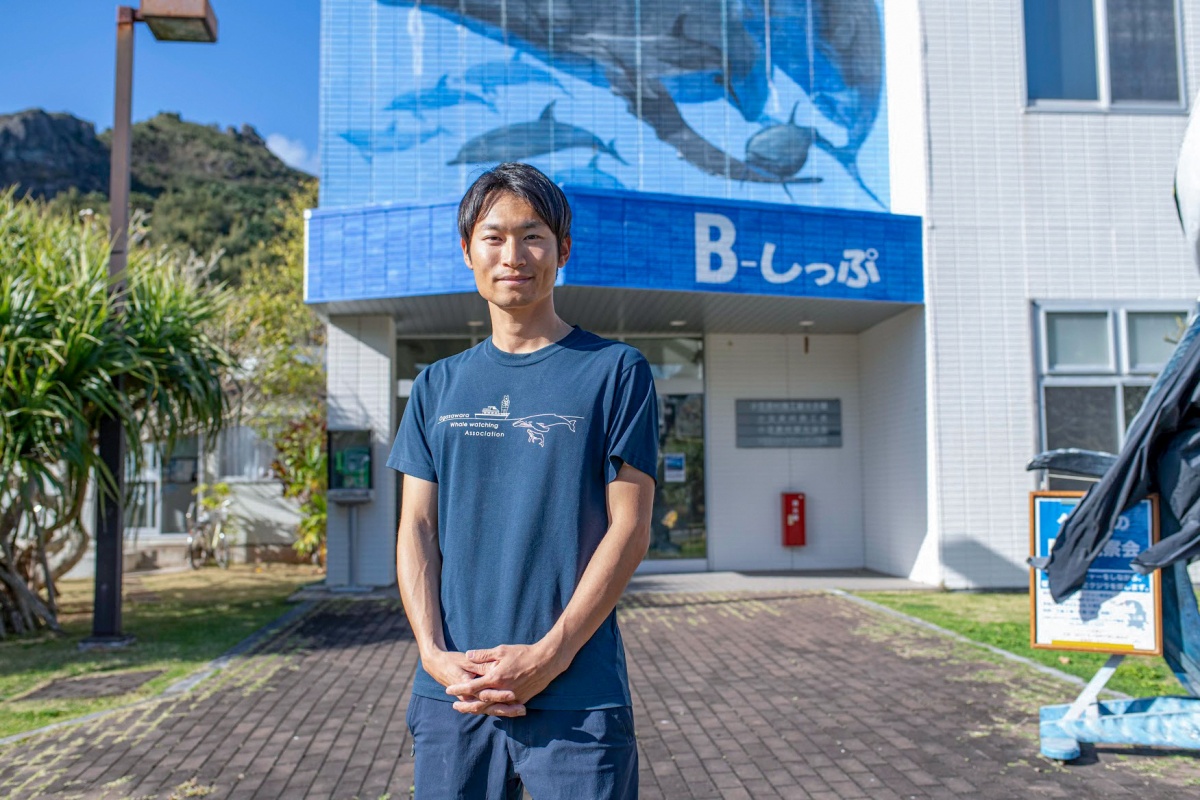
Researcher Koki Tsujii grew up in Osaka, with fond memories of playing in the ocean near Wakayama whenever he visited his grandmother. This love of the sea led to his studying marine biology at university and eventually to his present job on Chichijima island.
According to Tsujii, “half of the visitors to the islands come to dive or do other ocean related activities.” A focus on whale and dolphin identification schemes helps to increase knowledge and understanding of the marine life habitat, growth, population numbers, and behavior, so they can more effectively be protected. Individual identification of the Indo-Pacific bottlenose dolphin makes it easier to track changes in the animals and develop more effective guidelines relating to dolphin interactions and habitat protections.
By observing the identified dolphins, Tsujii and other researchers hope to reduce stress on the animals. Dolphins are not tagged physically, but instead photographs and video of the dolphins are analyzed to identify unique features such as coloring, scars and other characteristics. They are then given unique names.
They also visit the weather station lookout each morning to count whales and dolphins. The information and the photographs and videos they collect over the years are used in educational materials for locals and visitors. Tsujii hopes to get tourists, tour operators, guides, and locals to cooperate in identifying individual Indo-Pacific bottlenose dolphin by adding photos and videos they have taken to the database.
There are few protected areas for mammals, so this identification and data collection research on the Indo-Pacific bottlenose dolphins is important for future conservation of the oceans and marine life in the waters around Ogasawara.
Mr. Tsujii also conducts an individual identification experience program called the "Ogasawara Dolphin Lecture," which involves the bottlenose dolphins that have become a tourist attraction.
"When you think of a study session, it may seem formal, but the 'Ogasawara Dolphin Lecture' offers a fun way to learn about dolphin ecology, observation rules and individual identification surveys” he says. “The lecture lasts about an hour and covers the ecology of bottlenose dolphins living in the sea around Ogasawara and observation methods.
Participants can also experience individual identification by viewing the dolphin identification catalog. Both tourists and residents can join, but the content is geared towards those of middle school age and older."
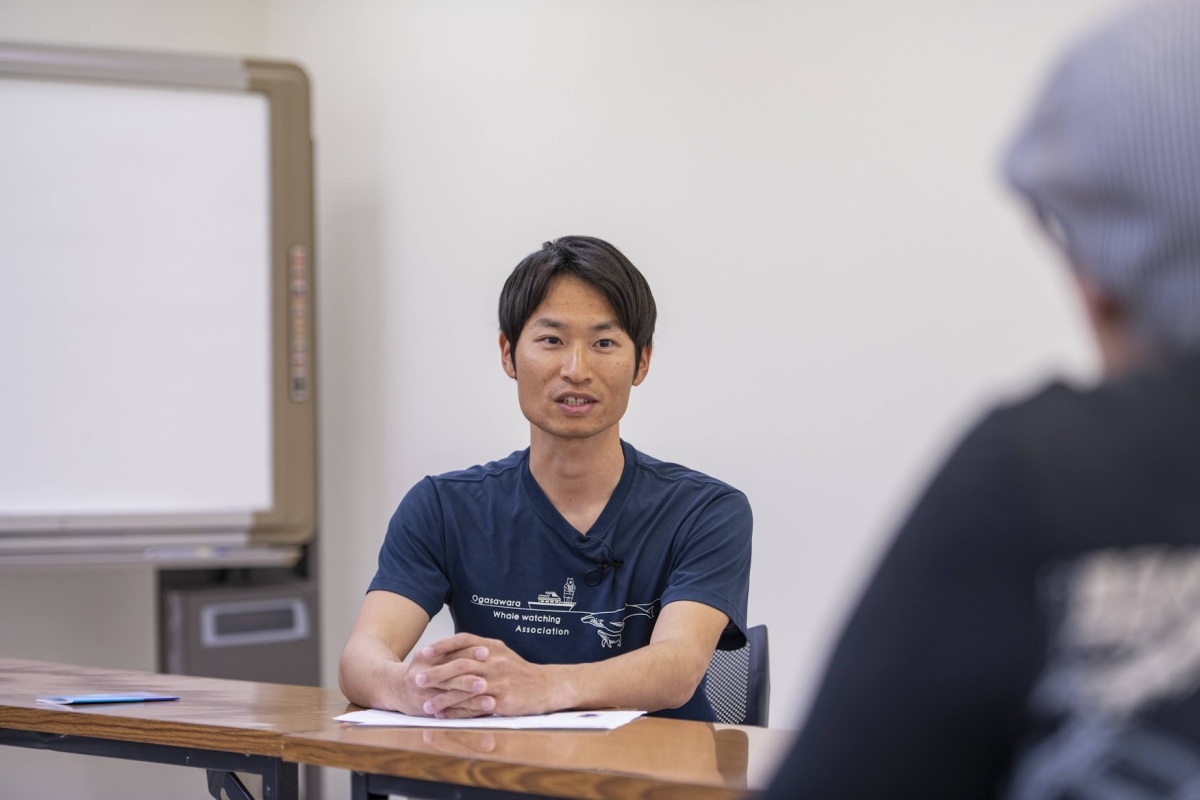
▲Koki Tsujii often gives seminars to locals and visitors about whales and dolphins.
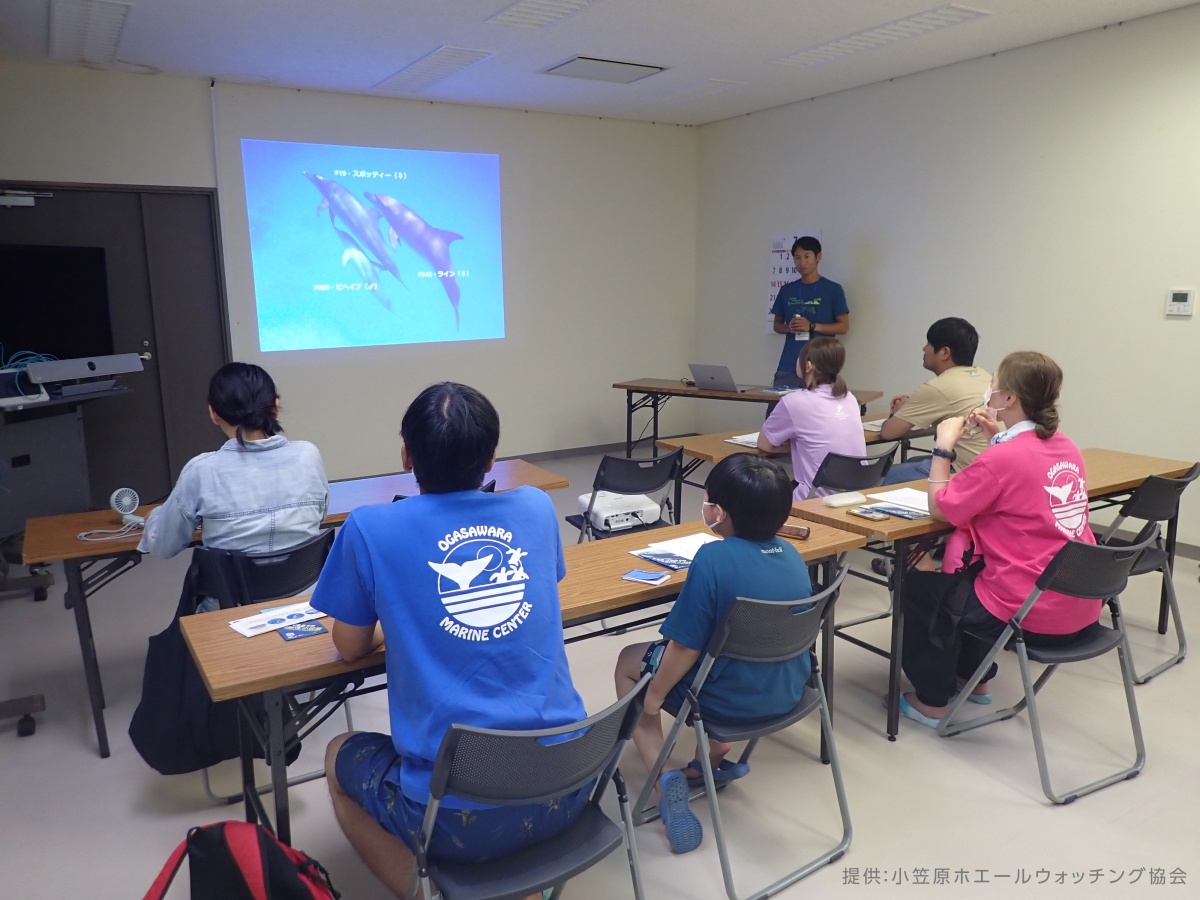
▲The "Ogasawara Dolphin Lecture" was conducted with the participation of tourists and island residents.
Creation of Bottlenose Dolphin Individual Identification Exhibits and Experience Facilities
The Ogasawara Whale Watching Association is creating exhibits and experience facilities related to the individual identification of bottlenose dolphins within its premises. Tsujii shares his thoughts on the preparation of these exhibits:
"We want more people to know about the individual identification surveys of dolphins that our association has been conducting for many years. Additionally, we have always thought about how we could involve the participants of dolphin swim tours in obtaining more research data. Therefore, this time, we decided to create an exhibit that not only educates and shares the results of our research but also allows everyone to enjoy identifying dolphins themselves. We hope that by utilizing these exhibit facilities, everyone will gain a deeper interest and understanding of the dolphins and research in Ogasawara, which will, in turn, contribute to the conservation of Ogasawara's dolphins."
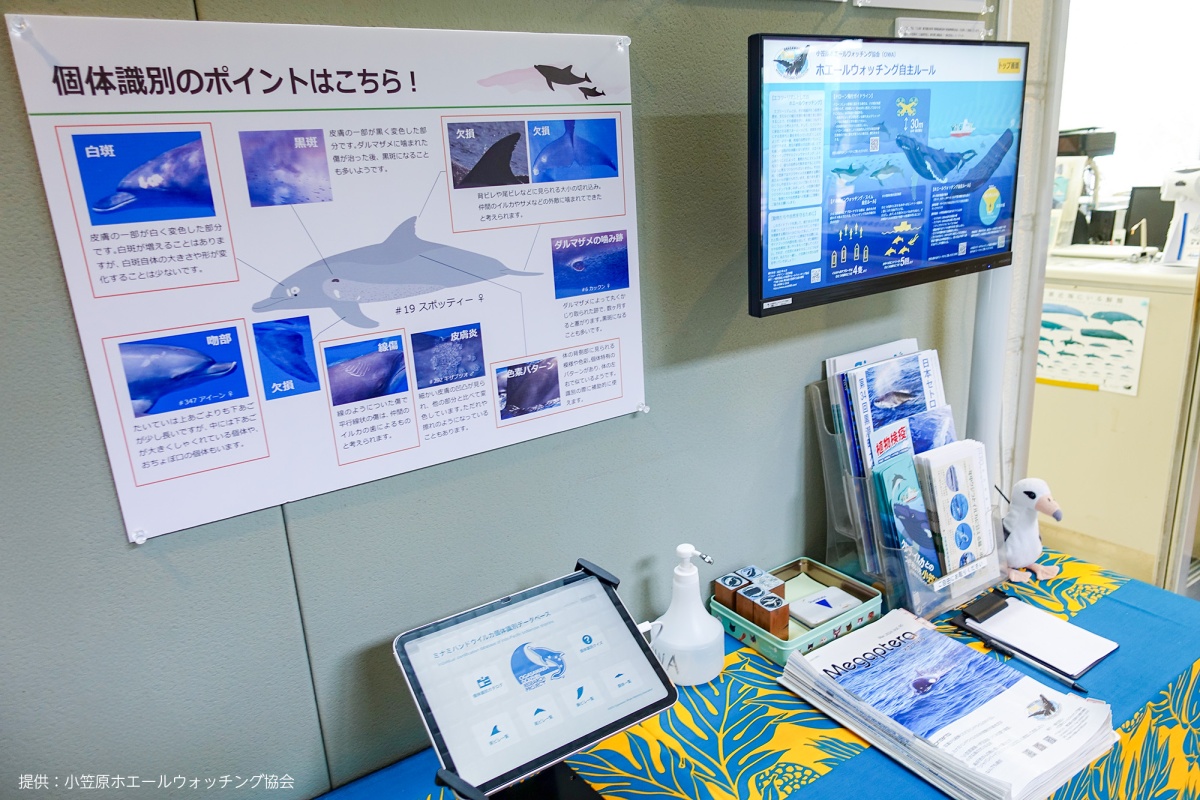
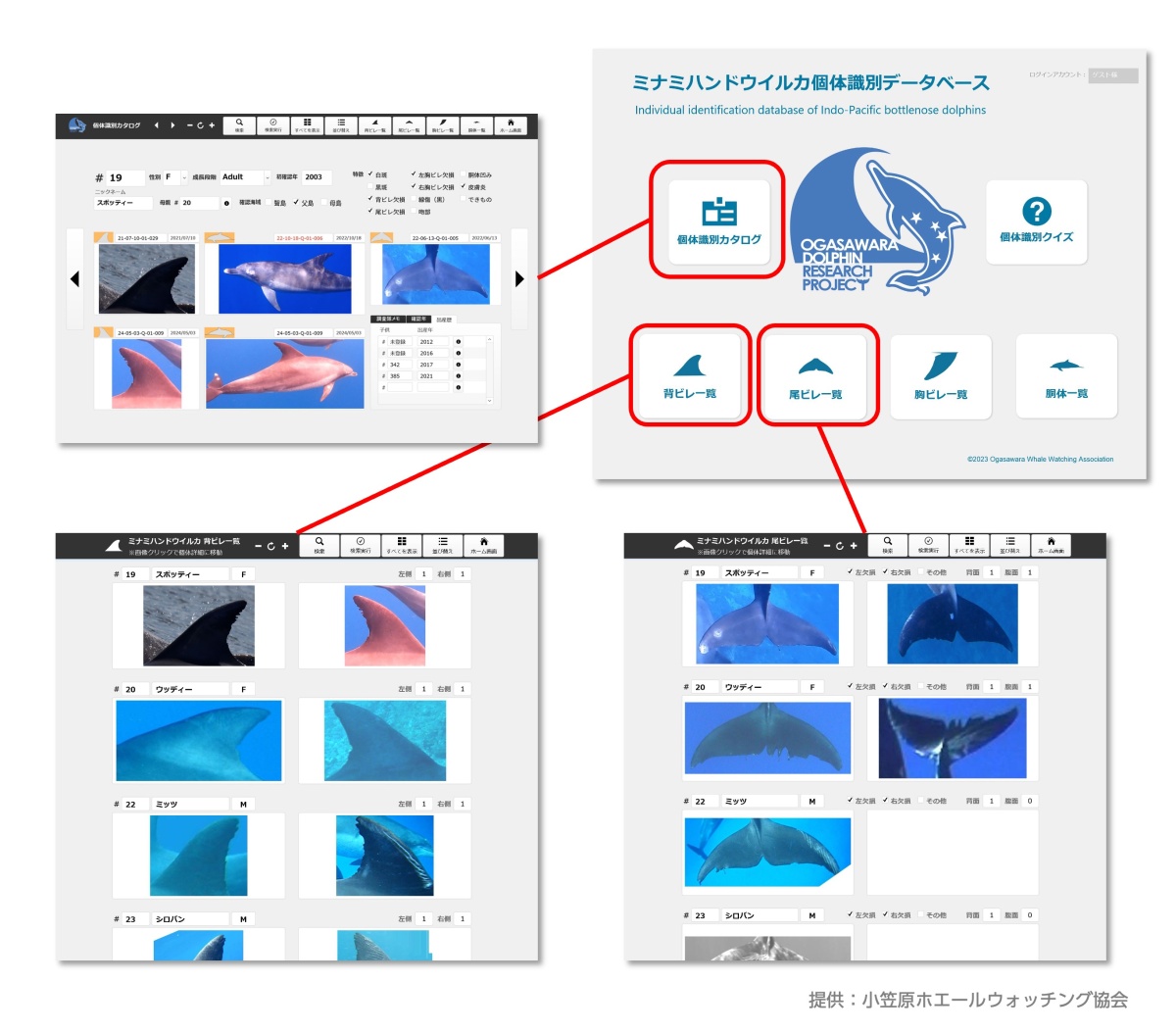
▲ At the Ogasawara Whale Watching Association's facility on Chichijima, visitors can learn about the individual identification of bottlenose dolphins in detail through tablets and panels.
The main feature of the exhibit is a database that includes all individually identified bottlenose dolphins. Mr. Tsujii says that he wants visitors to first learn about the dolphins through the informational panels that describe the ecology of bottlenose dolphins and the long-term individual identification surveys. By engaging with the individual identification database, visitors can develop a greater interest in the dolphins they might encounter in the future or have already met. The database will be regularly updated with the latest information.
This video clearly introduces the rules for protecting Ogasawara's natural environment. For example, it explains the rules for observing dolphins and whales, as well as specific actions for environmental conservation, allowing tourists to enjoy Ogasawara's nature while also contributing to its protection. Currently, this video is being shown on board the “Ogasawara Maru,” and Tsujii hopes that many people will learn about Ogasawara's rules through this video and become more aware of the importance of environmental conservation. "To pass on Ogasawara's rich nature to future generations, we want tourists to actively follow the rules and work together with us to protect the natural environment," he says.
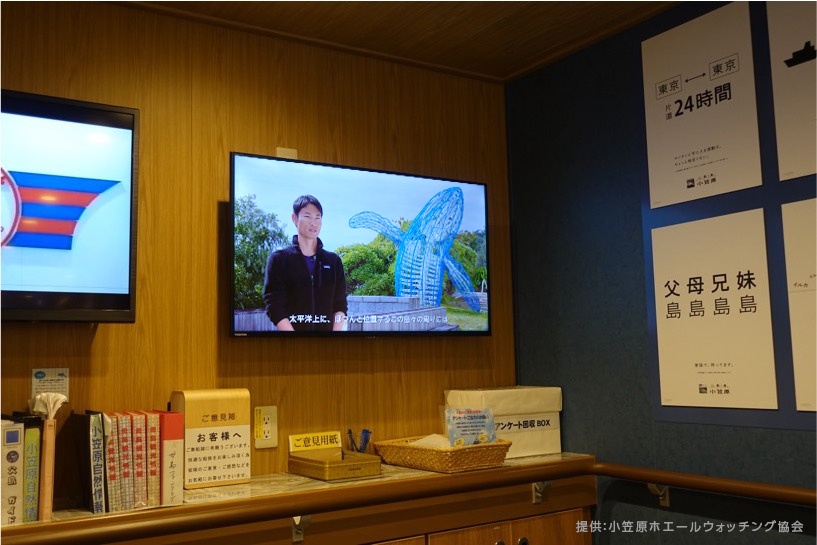
This video is shown on deck 4 of the passenger ship “Ogasawara Maru” to inform tourists about the voluntary rules in effect on the Ogasawara Islands.
【Islander.2】Ocean Adventure & Marine Life Tour Operator / Naoto Takahashi (President of Ocean Magic Co. and director of the Ogasawara Whale Watching Association)
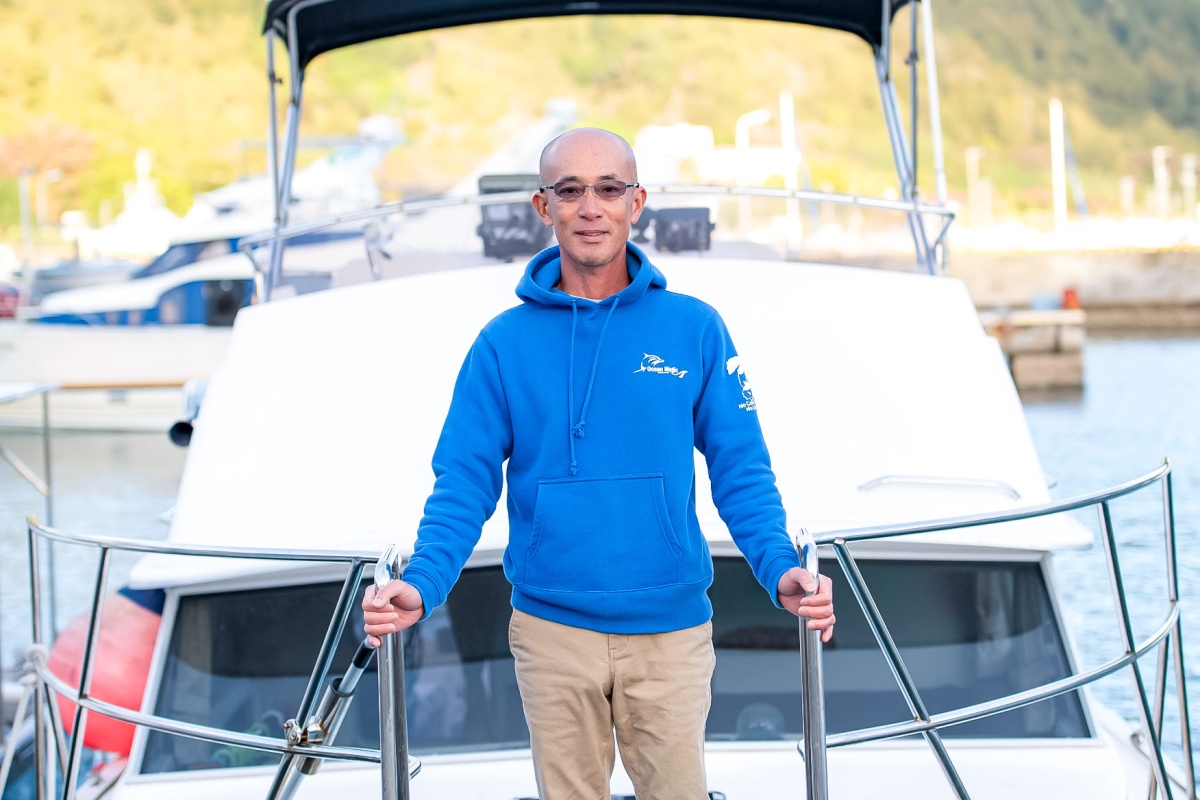
Naoto Takahashi first came to Chichijima as a student in 1997, only to form a deep love of the ocean and its marine life. He was especially impressed by the dolphins and whales which regularly visit the islands.
Now operating a whale-watching and swimming with dolphins tour business called Ocean Magic, Mr. Takahashi says there are strict rules to protect the animals. They include allowing no more than four boats to approach a pod of dolphins and limiting to five the number of guests that can go into the water from each boat. Those who go in the water are trained to limit movement of their hands and maintain distance to minimize stress on the animals.
For example, in the case of whale watching, the regulations stipulate that the area within 300 meters of the whale is a deceleration zone and the area within 100 meters is a no-entry zone for small boats of less than 20 tons, so as not to interfere with the whales’ path or behavior. For swimming with dolphins, the regulations stipulate that no more than four boats are allowed to approach a single pod of dolphins, and that no more than five entries into the ocean are allowed from one boat.
The tour operators have voluntarily set these guidelines in coordination with the Ogasawara Village Tourism Association and Whale Watching Association to protect the dolphins and create more sustainable business strategies. “Encounters with dolphins and whales are an extraordinary, once-in-a-lifetime experience only the operators in Ogasawara can offer,” says Takahashi.
Observational data collected from tour operators and their guests’ photos and videos can help in identifying individual dolphins, revealing behavior patterns, family relationships and health of individual dolphins. This contributes to further research and conservation.
Mr. Takahashi says that taking part in documentation and data collection helps educate visitors and enhances their experiences by including them in the conservation efforts. It also protects and preserves the dolphins and whales, while helping maintain successful business operations. Takahashi stresses the importance of operators preparing guests to be considerate and gentle with dolphins to ensure that tours can continue and the dolphins can live naturally.

▲Takahashi says that the whales and dolphins who revisit Ogasawara islands each year are recognizable.
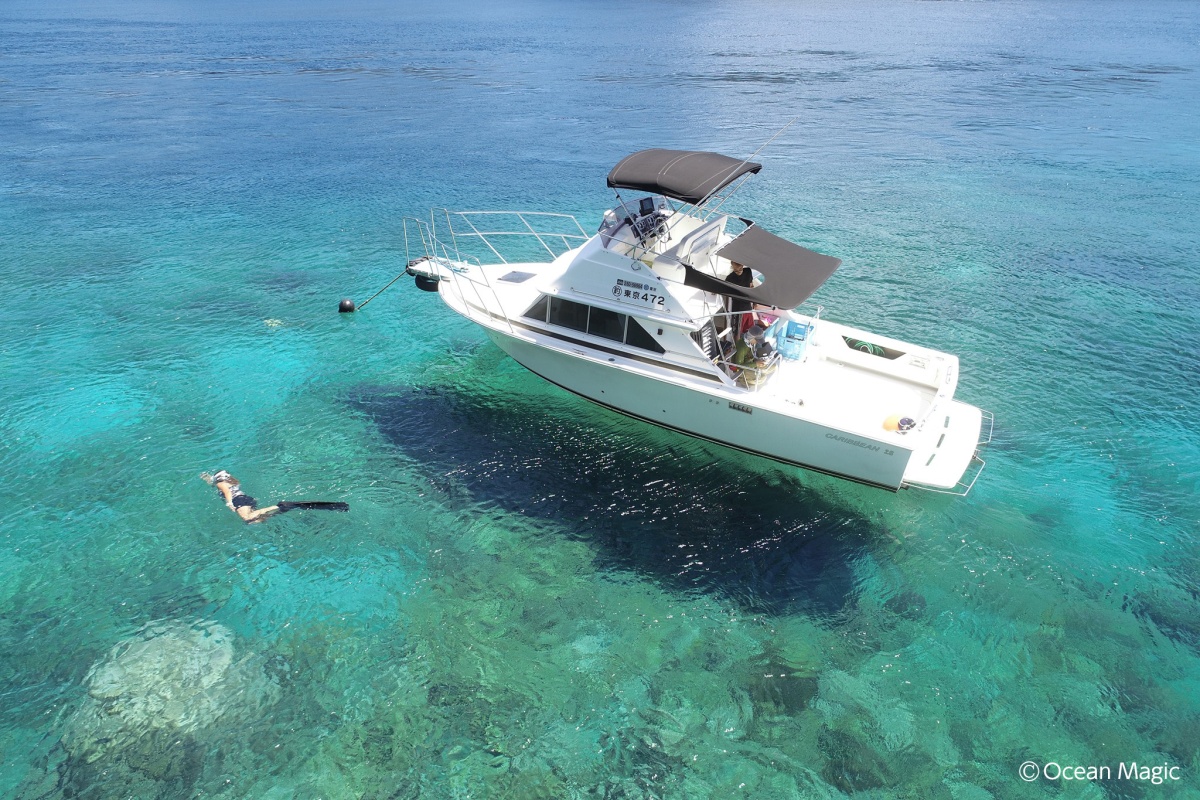
▲Dolphin sightseeing operations regulate themselves to protect the dolphins from stress in their interactions with visitors.
【Islander.3】Promoting Sustainable Tourism / Takashi Kaneko (The Deputy Mayor of Ogasawara Village on Chichijima island)
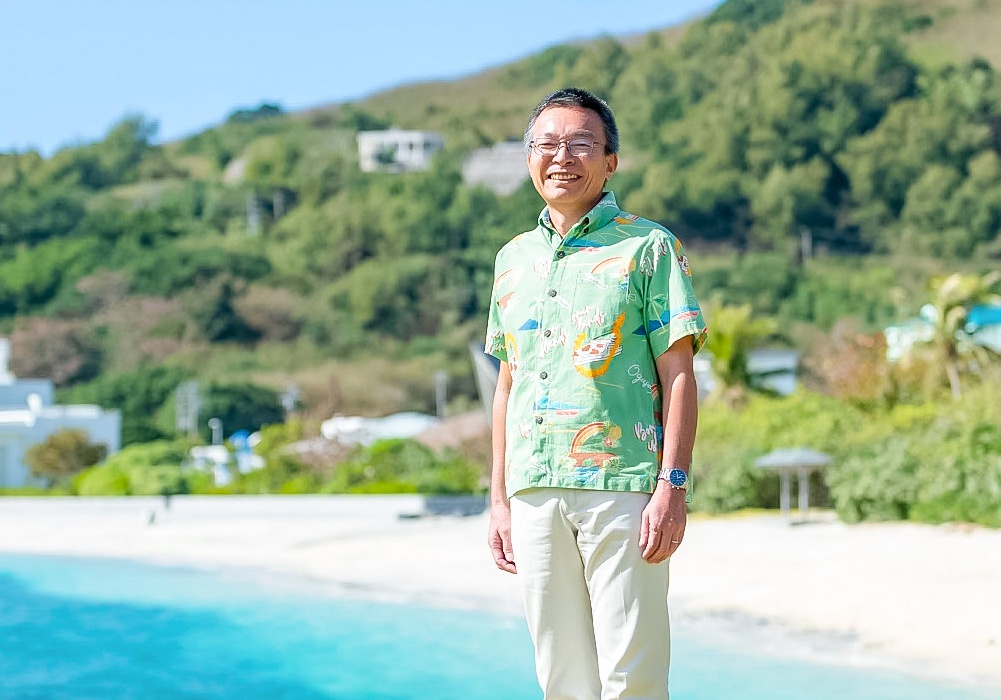
Takashi Kaneko, deputy mayor of Ogasawara village on Chichijima island, came to live on the island in 1989. He spoke about the government plans to promote ecotourism and eco-friendly behaviors to preserve and protect the unique nature reserve and the indigenous creatures which live here. By establishing rules and guidance, his office aims to make Ogasawara an ecotourism destination model in Japan.
Ogasawara has its own voluntary rules in addition to the regulations in force at all of Japan’s national parks. Through educational materials to schools, locals and visitors, tourism and daily conservation can be promoted, Kaneko says. Collaborating with eco-tour guides and tourism officials is another key aspect of effectively educating the public.
By promoting “responsible tourism,” visitors are encouraged to respect Ogasawara’s environment, history and local culture and preserve the island’s unique appeal. Visitors can travel responsibly and respect the sea and its creatures by picking up plastic from the beaches, using more environmentally-friendly products and hiring eco-guide services. The Indo-Pacific bottlenose dolphin identification program is another meaningful way visitors can enjoy travel in Ogasawara while learning more about the marine life.
Deputy Mayor Kaneko mentioned the island’s connection to Hawaii and the many locals who practice hula and enjoy outrigger canoeing. Inspired by ecotourism standards in Hawaii, they have also established some ideas on policies to protect the marine life. Visitors to Ogasawara are also encouraged to engage in sustainable efforts.
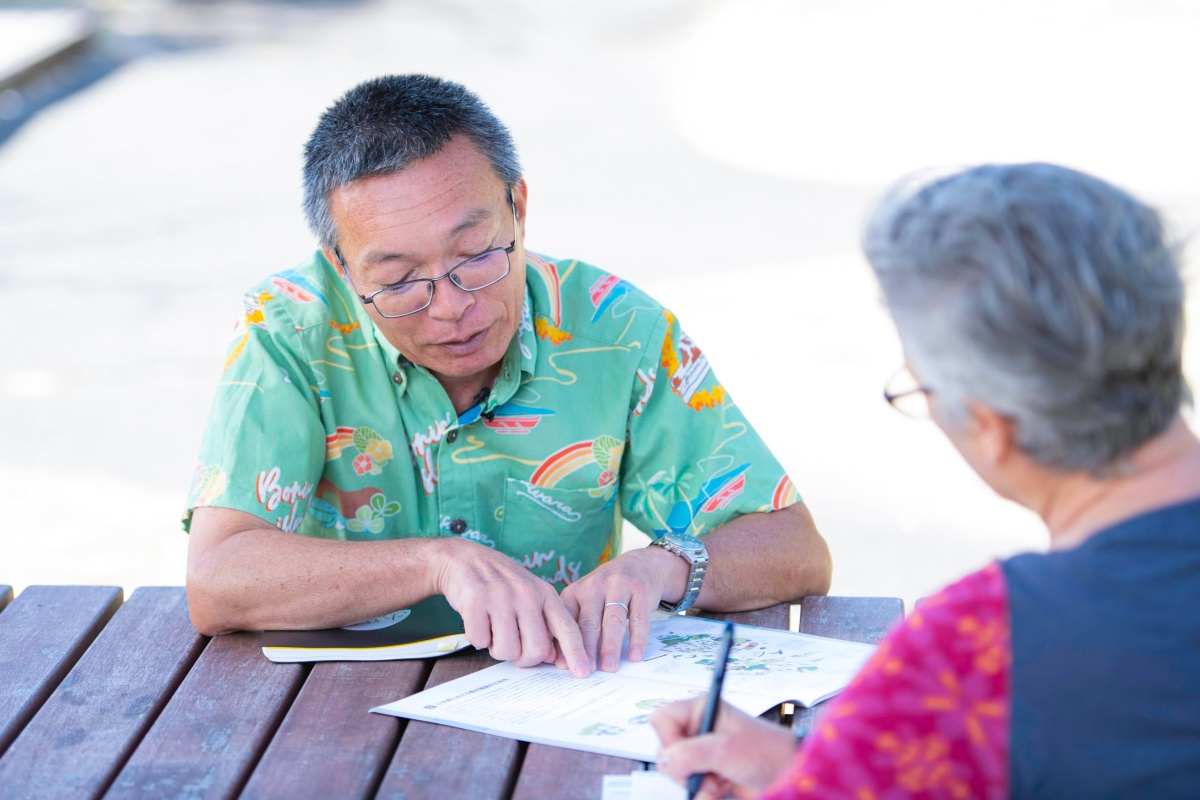
▲The Ogasawara Village Tourism Promotion Vision was established in 2023, aimed at balancing the needs of the environment, visitors and local people over the next 10 years.
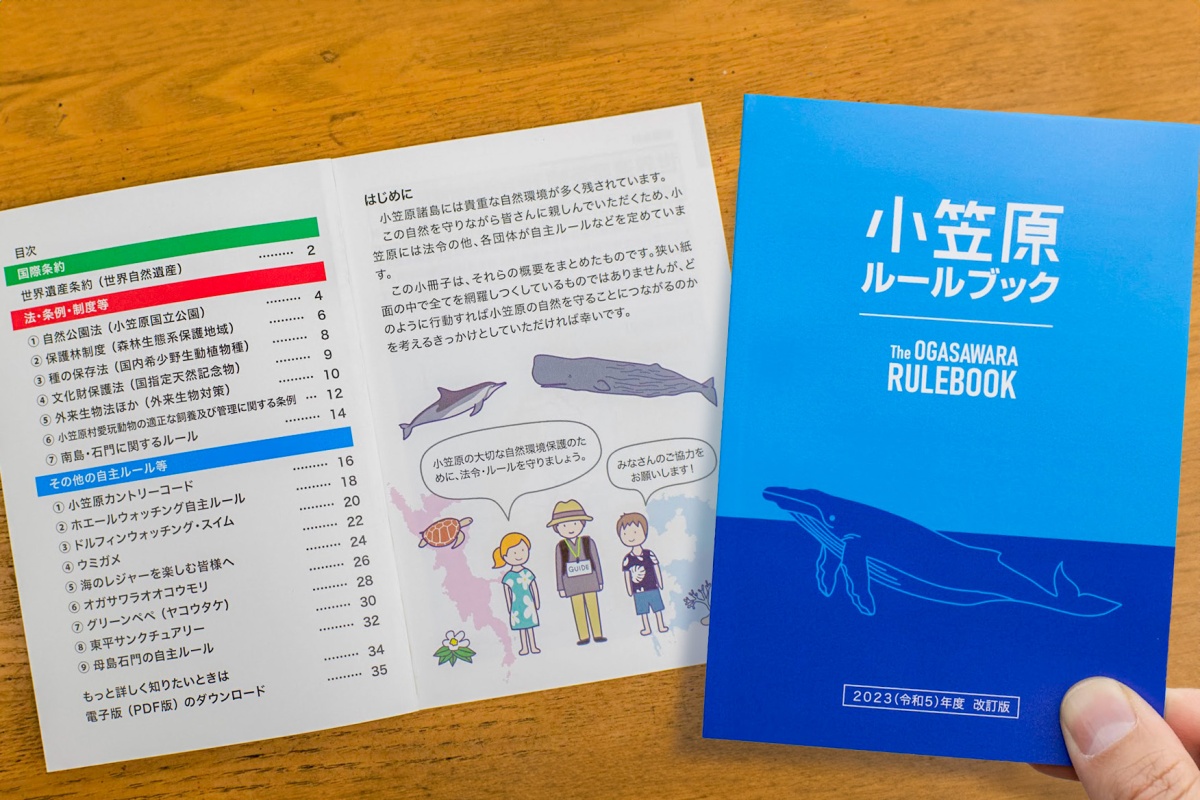
▲Ogasawara village publishes its own guidelines for education, tourism and environmental protection.
Local Entrepreneurs on Chichijima Help Build a More Resilient Future

▲The Chichijima Weather Station is a wonderful place to watch humpback whales from January to April.
Motomi Nose operates Nose Farm on Chichijima Island, where she grows coffee and spices. She inherited the farm from her father who had to evacuate the island during WWII. Growing these crops is a real challenge, and Nose farm has attracted a lot of attention, particularly as there are so few coffee growers in Japan.
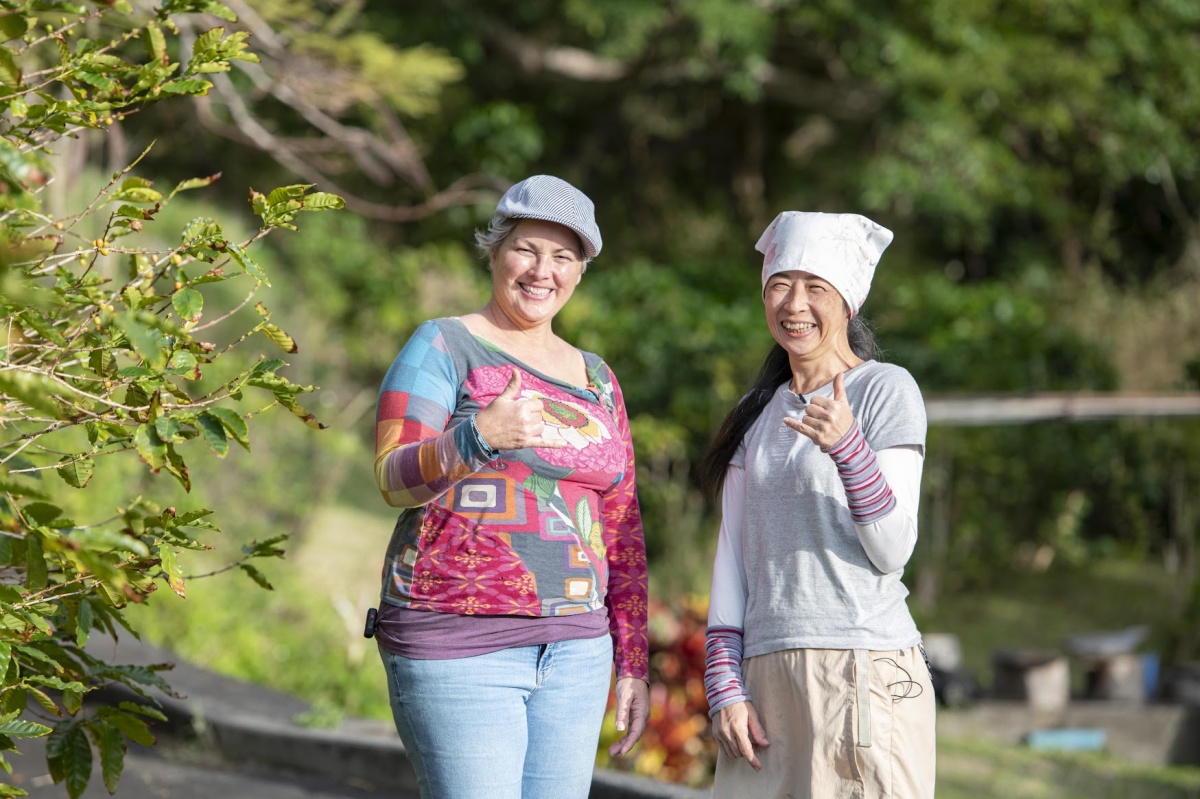
▲Motomi Nose gives educational tours to visitors at her family’s coffee and spices farm.
The farm is also actively involved in the conservation of Ogasawara's natural environment. Ms. Nose practices pesticide-free cultivation to protect the rich natural environment of Chichijima and conveys the importance of nature conservation to tourists through his activities at the farm. During tours of Nose Farm, visitors are introduced to sustainable farming practices in harmony with Ogasawara's nature through experiences such as coffee harvesting and roasting.
In 1878, the Ogasawara Islands became the first place in Japan to attempt coffee cultivation. Despite the harsh conditions brought about by the war, the coffee trees faced extinction. However, the coffee trees left by the previous generation naturally dropped their seeds and grew wild. Wild animals prefer to eat the pesticide-free coffee cherries, and the seeds that are left behind naturally sprout, allowing the farm to continue pesticide-free cultivation. This demonstrates the ongoing practice of sustainable agriculture in harmony with the natural environment of Ogasawara.
Nature guide Tadashi Kurumizawa leads night tours to view the fascinating flying foxes who are active at night in the fruit trees. Originally attracted to the islands as a surfer, he has now been a guide on Chichijima for over 27 years. Kurumizawa says he enjoys showing visitors the hidden features of the island’s plants, animals, and history.

▲Tadashi Kurumizawa is a 27-year veteran nature guide who shares some of the best spots with visitors.
Dolphin and Whale Watching Attractions Help Sustainable Tourism
Watching whales and dolphins in the seas of the Ogasawara Islands is part of the island chain’s unique appeal to visitors. Rules based on the ethical preservation of marine life in Hawaii were established in the 1980s, and islanders also still connect to Hawaiian culture through such activities as outrigger paddling and the hula culture.
Now you can play an active role in conservation and sustainable activities. Through the dolphin identification program, videos and photographs taken by visitors can contribute to important research, leading to a more detailed understanding of the Indo-Pacific bottlenose dolphin. These positive actions as tourists can go a long way to help support the local economy as well as ensure preservation of these stunningly unique nature reserves in Tokyo’s tropical Ogasawara islands.
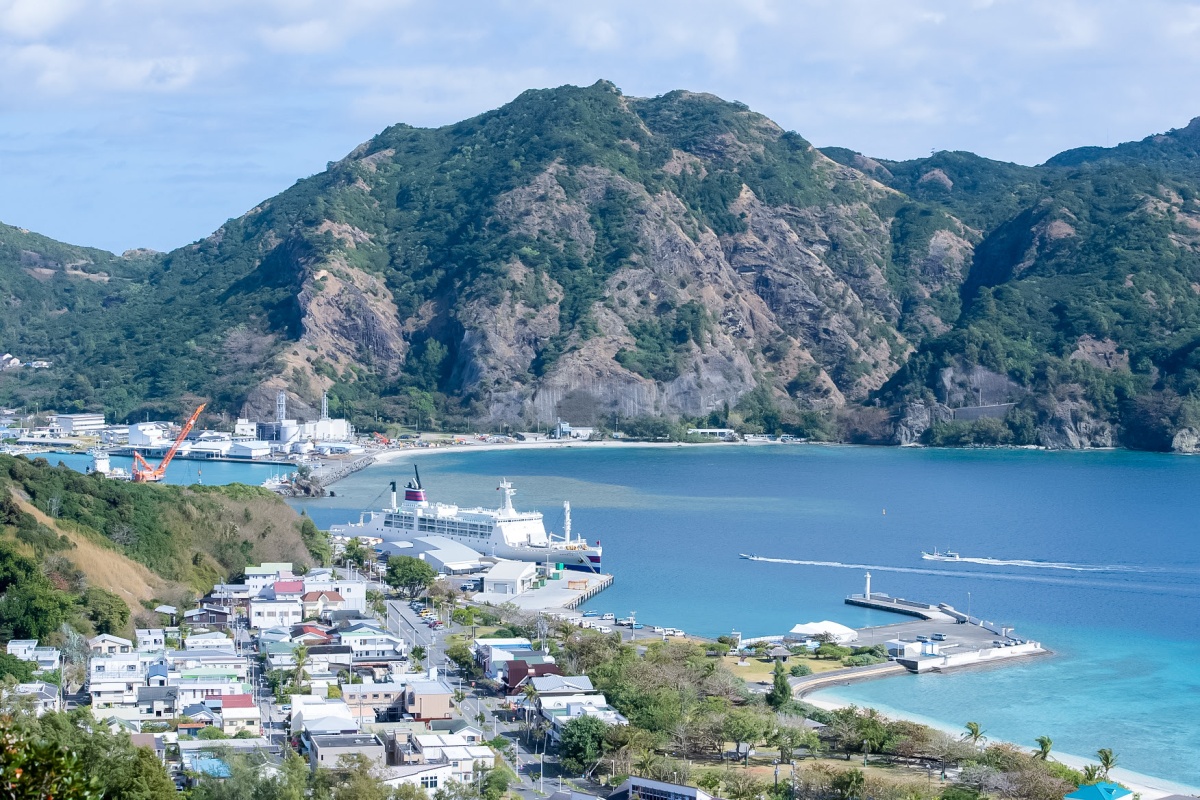
Chichijima’s main connection to the rest of the world: the Ogasawara-Maru ferry at the Futami port dock.
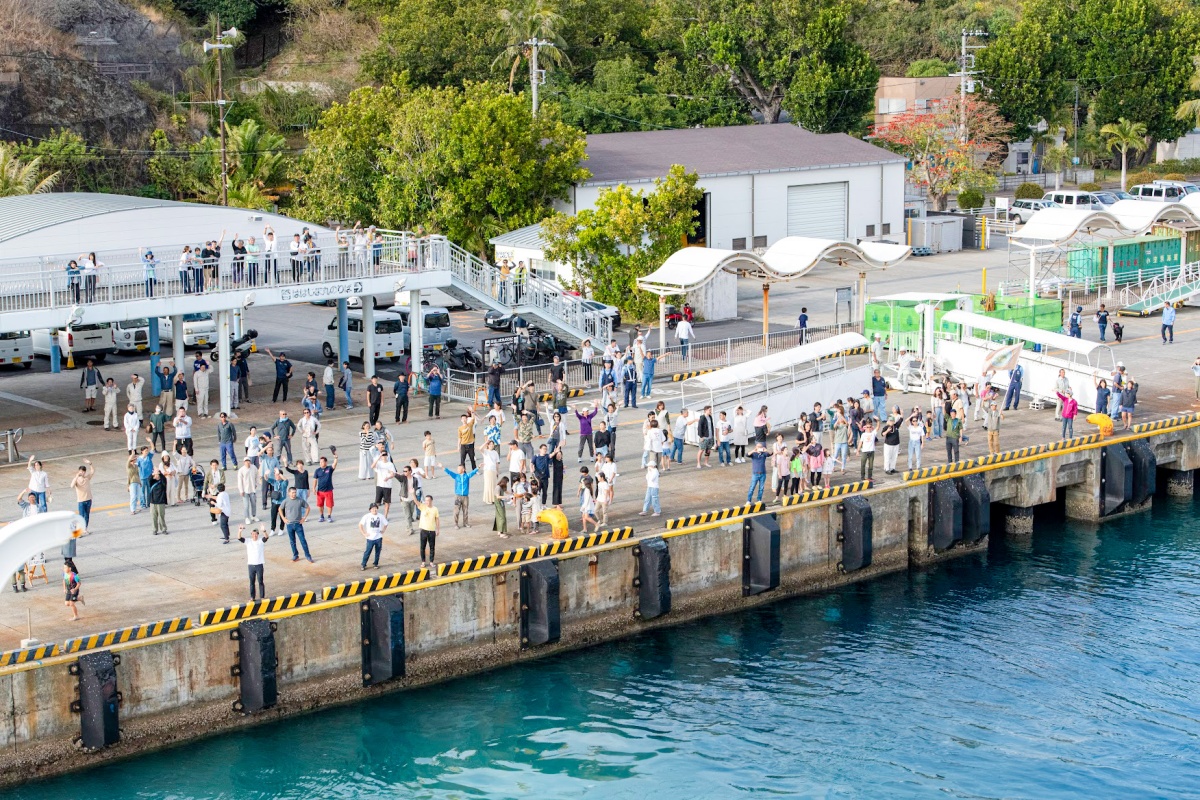
Locals come to the port to both welcome and see off visitors who come by ferry to Ogasawara from Tokyo.

[Reporter] Joy Jarman-Walsh
Joy first came to Japan from Hawaii, and in Hiroshima since 1996 where she co-founded the regional website GetHiroshima, taught business, communication, and tourism studies at university and launched her sustainability-focused business InboundAmbassador in 2019. The Seek-Sustainable-Japan show Joy creates has over 470 interviews with experts, authors, craftspeople and insiders from across Japan.
This content is supported by a grant from the Tokyo Convention & Visitors Bureau for the Promotion of Environmentally Friendly Travel.



